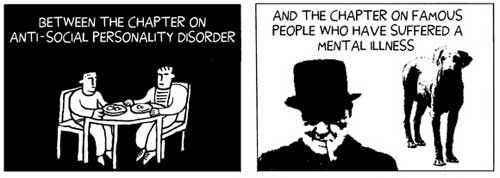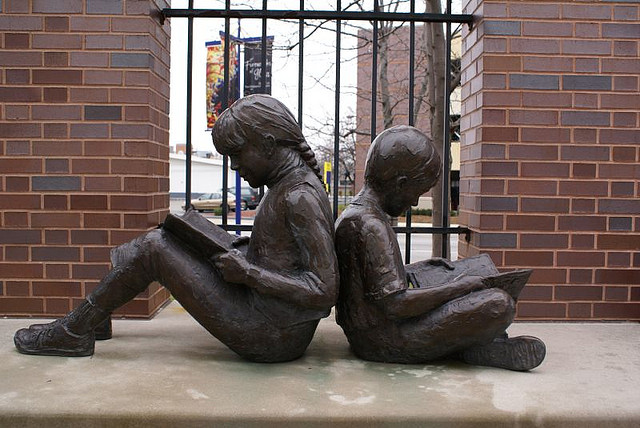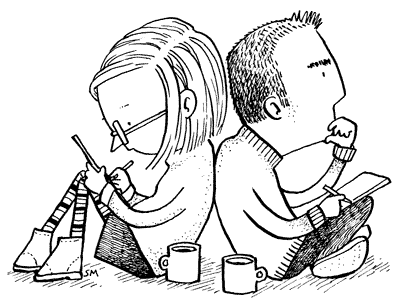new posts in all blogs
Viewing: Blog Posts Tagged with: cunningham, Most Recent at Top [Help]
Results 1 - 8 of 8
How to use this Page
You are viewing the most recent posts tagged with the words: cunningham in the JacketFlap blog reader. What is a tag? Think of a tag as a keyword or category label. Tags can both help you find posts on JacketFlap.com as well as provide an easy way for you to "remember" and classify posts for later recall. Try adding a tag yourself by clicking "Add a tag" below a post's header. Scroll down through the list of Recent Posts in the left column and click on a post title that sounds interesting. You can view all posts from a specific blog by clicking the Blog name in the right column, or you can click a 'More Posts from this Blog' link in any individual post.

By: Alice,
on 6/24/2014
Blog:
OUPblog
(
Login to Add to MyJacketFlap)
JacketFlap tags:
Books,
reading,
Education,
child development,
jamie,
readings,
cunningham,
*Featured,
American Academy of Pediatrics,
Health & Medicine,
Psychology & Neuroscience,
Anne E. Cunningham,
book smart,
jamie zibulsky,
zibulsky,
How to Develop and Support Successful,
Motivated Readers,
recommended parent-child reading time,
calmly,
decode,
anne,
child,
Add a tag
By Jamie Zibulsky, Anne Cunningham, and Chelsea Schubart
Throughout the process of reading development, it is important to read with your child frequently and to make the experience fun, whether your child is a newborn or thirteen. This may not sound like news to many parents, but the American Academy of Pediatrics is just announcing their new recommendation that parents read with their children daily from infancy on, and it is expected that this announcement will serve as a reminder to many parents and a call for educators and policymakers to help parents who lack the time, resources, and skills to read with their children encourage reading development. We are so excited about this new development because the benefits of shared reading accrue over time and we believe that this announcement will create the energy needed to help many young children become successful, motivated readers.
Although reading together is important at all ages, the specific strategies parents use will change dramatically as their children get older. The strategies parents use will also be dependent upon their children’s interests, temperament, and abilities. There is no one “right” way to read together.
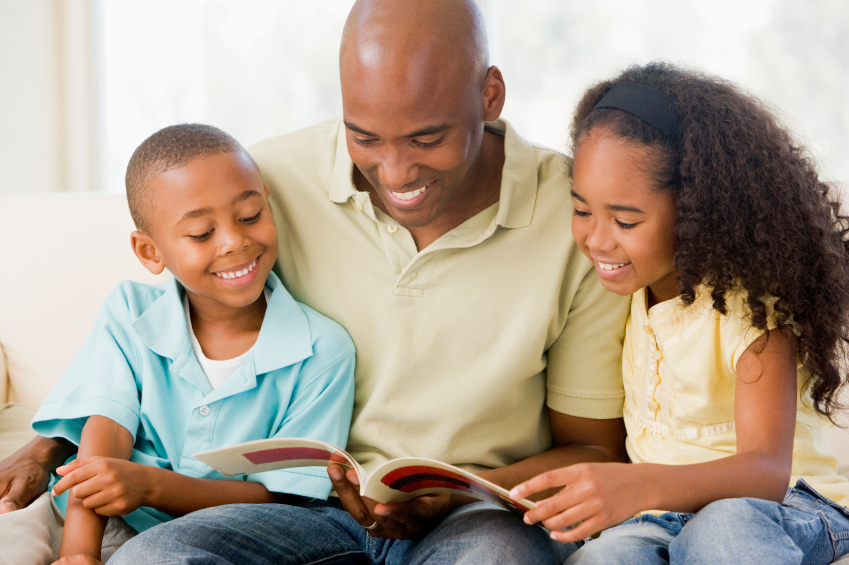
Figuring out the best way to engage in shared reading with a child while he or she is young gives parents an opportunity to use cuddle time together as a way to also help a child understand a book more deeply, and to simultaneously teach specific reading skills. Perhaps as important, children who have an enthusiastic reader as a role model may stay determined to learn to read, even when facing challenges, rather than becoming easily discouraged. The magic of shared reading comes from this combination of warm, interpersonal experiences, playful and captivating storytelling, and opportunities for learning. This winning combination helps children not only learn to read, but learn to love and value reading.
There are many questions that parents often ask about reading together with their children, and some of those questions are answered below. We hope that thinking through these issues inspires parents to start reading with their children regularly (even if they are already a bit older), and create family reading rituals that last a lifetime!
How can I get my child more engaged in reading time?
If you are having difficulty engaging your child in reading time, try searching for books on topics that she finds interesting (even if those topics are not ones that you find engaging). If your child enjoys looking at comic books, embrace this type of reading, rather than discouraging it. Although it might be surprising to hear, they include much richer language than we encounter in a typical day. Reading any printed material also helps children get comfortable turning pages, and give you the chance to talk with your child about new ideas and vocabulary words.
Many children also respond well to having some freedom and getting to make choices during reading time. You may want to let your child to choose the book you will be reading, whether you are picking books out in the library or off your own bookshelf. You can also let your child select where and when you will read…within reason, of course.
Most importantly, try to make the reading experience enjoyable by focusing on what goes well. Praise your child just for sitting down with you to read, even if she only wants to sit briefly. The next day, try to get her to sit through a few pages of the story and sit a bit longer. Reading time should be a time to relax and bond with your child. If she acts up, simply end reading time, but do so calmly and try again later.
How do I know if my child is actually listening while I am reading to him/her?
Asking questions throughout the story that actively engage your child in the reading process should encourage him to listen more closely while you are reading. If you think your child is not listening as you read, try asking a question or two on each page in order to get your child to interact with the story and actively express himself. If he seems particularly distracted, simply end reading time, but do so calmly and try again later.
How long should I spend trying to explain something to my child if they get frustrated?
Reading time should be a relaxing, bonding experience for both you and your child. Rather than trying to teach many new skills during any one reading session, pick just one idea to focus on each day, whether it is a new vocabulary word or letter to identify. Setting manageable reading goals will help make this time feel fun, rather than stressful, for you both.
If you ask a question about a book that your child is having trouble understanding, respond calmly and either restate your question in a simpler way or give a clue regarding the correct answer. If she seems to be frustrated, move on and return to the concept at another time. Story concepts might become clearer to children with repeated readings of the same story.
What if my child wants to read the same book every night?
Repeated readings of a story actually help children to more deeply understand the plot. In addition, your child will grow more familiar with the story and the words that make it up. You can even try having your child read to you. If he is familiar with the book, he might be able to decode words he would not be able to decode in an unfamiliar context. If your child is not ready to actually read the words on the pages, have him retell the story to you using the pictures and what he recalls from other readings of the story. By asking questions and making comments, you can continue to build his vocabulary and background knowledge, even while reading a familiar story.
Anne E. Cunningham, Ph.D. and Jamie Zibulsky, Ph.D. are the authors of Book Smart: How to Develop and Support Successful, Motivated Readers. Anne Cunningham is Professor of Cognition and Development at University of California Berkeley Graduate School of Education and Jamie Zibulsky is Assistant Professor of Psychology at Fairleigh Dickinson University. Learn more at Book Smart Family. Suggestions are adapted Book Smart: How to Develop and Support Successful, Motivated Readers by Anne E. Cunningham and Jamie Zibulsky. Read their previous blog posts.
Subscribe to the OUPblog via email or RSS.
Subscribe to only brain sciences articles on the OUPblog via email or RSS.
The post Common questions about shared reading time appeared first on OUPblog.


By: Elizabeth Gorney,
on 4/13/2014
Blog:
OUPblog
(
Login to Add to MyJacketFlap)
JacketFlap tags:
teaching,
Education,
parenting,
child development,
jamie,
cunningham,
*Featured,
Psychology & Neuroscience,
Anne E. Cunningham,
book smart,
jamie zibulsky,
World Literacy Summit,
valeriebb,
zibulsky,
Books,
reading,
literacy,
Add a tag
Oxford University Press is a proud sponsor of the 2014 World Literacy Summit, taking place this April. The Summit will provide a central platform for champions of literacy from around the globe to come together and exchange points of view, knowledge, and ideas. We asked literacy experts Jamie Zibulsky and Anne E. Cunningham to discuss the importance of literacy on this occasion.
By Jamie Zibulsky and Anne E. Cunningham
Being literate involves much more than the ability to sound out the words on a page, but acquiring that skill requires years of development and exposure to the world of words. Once children possess the ability to sound out words, read fluently, and comprehend the words on a page, they have limitless opportunities to learn about new concepts, places, and people. To say that becoming a reader gives one the power to change is an understatement. In fact, attempting to detail the many ways that reading can foster personal growth and development without writing an entire book on the topic is truly challenging!
Children’s capacities to build the many skills required to access text are, to a large degree, determined by their environments. Parents and teachers play a critical role in introducing children to the sounds of words, the print on a page, the ideas and concepts that provide the background for comprehension, and the structure of stories. For these reasons, if we want to ensure that all children have the opportunity to become successful, motivated readers, we need to think about the power the adults in their lives have to change children’s literacy trajectories.
The language and literacy experiences of young children are largely social in nature, and both the environment and the adults that care for them initially guide children’s development. In fact, psychologists point out that language development occurs first as a social act between people and then later as an individual act, as we gradually internalize the directions, strategies, and advice of more skilled others by verbalizing them to ourselves. Similarly, to make sense of the written symbols used to convey any language, children need guidance from the adults in their lives. Talking and reading together with children is a powerful way to help them gain entry to the world of words, and doing so most effectively may require parents to change their current practices.
Here are some powerful tips that families can use to make shared reading time supportive and effective for young children learning a variety of languages:
- Let your child take the lead during reading time. We often think of reading together as a time when a parent reads a story to a child straight through, page by page. Instead, let your child take more of an active role by using the pictures to narrate the story, answering your questions about aspects of the book, or sounding out some words independently. This may feel like you and your child are swapping your regular reading roles. And that’s exactly what we want you to do. Even before children are able to read independently, they are ready to be active participants in book reading experiences. Giving them these opportunities helps children build stronger language skills, and provides some insight into their skills and interests.
- Give your child hints, rather than providing the answer, when he is struggling. This support helps the child solve the problem in a way that allows him to feel competent and to learn from the situation, but also lets the adult to guide the child through the problem-solving process. In addition, it gives him the chance to successfully experience tasks he would not have been able to tackle alone, or that would otherwise make him become frustrated and give up.
- Identify your child’s strengths, and those reading skills he or she already possesses. Providing experiences that build on the skills your child already possesses will allow her to enhance her learning capacities. If you think about almost any activity you expect your child to complete, you can probably think back to a time when you completed that activity for her. Gradually, over time, she took more responsibility and was able to do more of the task independently. This is not only true for activities like getting dressed and tying shoes, but also for language and literacy tasks, as well as tasks that require memory and concentration.
- Label the behavior that you want your child to display, and praise it specifically. Praise and encouragement from parents is a powerful motivational tool. Because shared reading is such a social activity, much of your child’s initial pleasure in reading together may come not primarily from the stories that he hears, but from the joy of sitting in your lap and spending time together. Your child values the time you spend together and will, over time, begin to value the books in front of him and the strategies needed to make sense of them. You can help him build his reading motivation by praising specific skills he displays, like listening carefully, sounding out words, and making great predictions.
Each of these tips helps set the stage for a successful shared reading experience, but may require change on the part of parents to help foster a powerful and engaged reader. These changes, though, help empower children to identify themselves as readers from the time they are young. And this strong foundation prepares them for so many challenges they will face in the future, so doing everything one can to raise a successful, motivated reader is one of the best gifts a parent can give any child.
Anne E. Cunningham, Ph.D. and Jamie Zibulsky, Ph.D. are the authors of Book Smart: How to Develop and Support Successful, Motivated Readers. Anne Cunningham is Professor of Cognition and Development at University of California Berkeley Graduate School of Education and Jamie Zibulsky is Assistant Professor of Psychology at Fairleigh Dickinson University. Learn more at Book Smart Family.
Subscribe to the OUPblog via email or RSS.
Subscribe to only brain sciences articles on the OUPblog via email or RSS.
The post Parent practices: change to develop successful, motivated readers appeared first on OUPblog.

Last night I went along to Brick Lane for the monthly meeting of Laydeez Do Comics. I went partly to hear the talks, but partly to see my friend Darryl Cunningham, who lives way up in Keighley in Yorkshire, so any visit to London is a big deal.

Bloomsbury in the USA had just sent him some author copies of the American version of his book Psychiatric Tales, which comes out next month (but is already unofficially hitting the shelves), and he gave me a copy! And then I was super chuffed to find my name in it! Yay! Thanks, Darryl!

New introduction to the American edition of Psychiatric Tales
I did a few rough doodles in my notebook during the talks:

The presentations covered a lot of ground in comics and social history, but I'll post a few links the speakers mentioned. Corinne Pearlman flagged Myriad Editions' First Graphic Novel Competition, a chance to publish a book with them, with a £10 entry fee and final date of 1 Oct 2011.
Ed Hillyer (aka Ilya) talked about being sent to Indonesia by the British Council to meet with other comic artists and come up with a app-friendly comic based on a deteriorating painted mural at the Jakarta History Museum. (You can see some British Council Flickr photos here.)
Dr Julia Round promoted the Studies in Comics Journal and encouraged people to submit comics and academic paper to its future publications.
And my favourite bit was when the lights went on, the Powerpoint went off, and Erica Smith, creator and editor of Girl Frenzy got out her collection of old comics and zines:
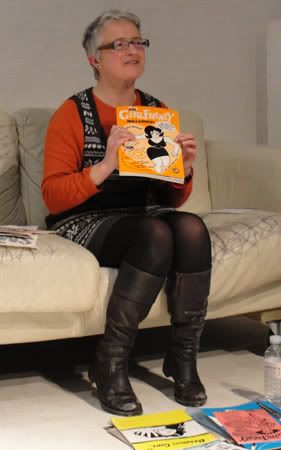
Erica Smith
Erica linked a lot of things to punk feminist movement Riot Grrrl, which I feel I ought to know way more about, since it was based in my part of the world, but I was very young then and Riot Grrrl wasn't exactly a household name among the suburban, makeup-wearing, Republican-voting mothers of the kids in my school. We had a good discussion about the place and significance of self-published zines, and if blogs have taken over from them. I loved seeing the period typefaces and old-tech printing techniques. People in the audience suggested that most zines ten years ago were about music and bands, and MySpace had been doing the job that zines had done previously. But with current obsession with all things retro, and lower printing costs, zines have made a big comeback, with events such as the Alternative Press Fair (where I ran my first-ever comics stall; more photos and write-up from David O'Connell) and London Zine Symposium.
The other great thing about Laydeez Do Comics is getting to see all the people I vaguely know from the Internet as being potentially lovely people, but are much more comfortable chatting with when I've met them in real life. I've run into quite a few C
This weekend I had a fabulous time in Oxford at Caption comics festival! But first, a word from The Fleece Station (...look, my desk!):
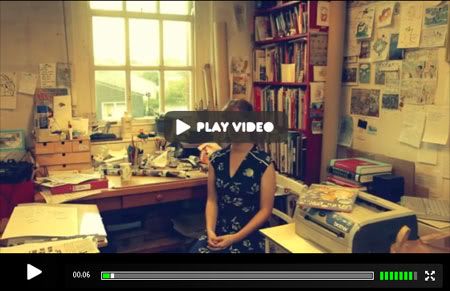
My fab studio mate, Ellen Lindner has been busy putting together an anthology with comics by Ellen, me and a whole bunch of great UK-based comics folk, including Francesca Cassavetti, Tanya Meditzky, Cliodhna Lyons and a whole bunch others. But it needs your pre-orders to get off the ground! Watch the video, then visit this site for details!
Some faces I sketched at Caption:
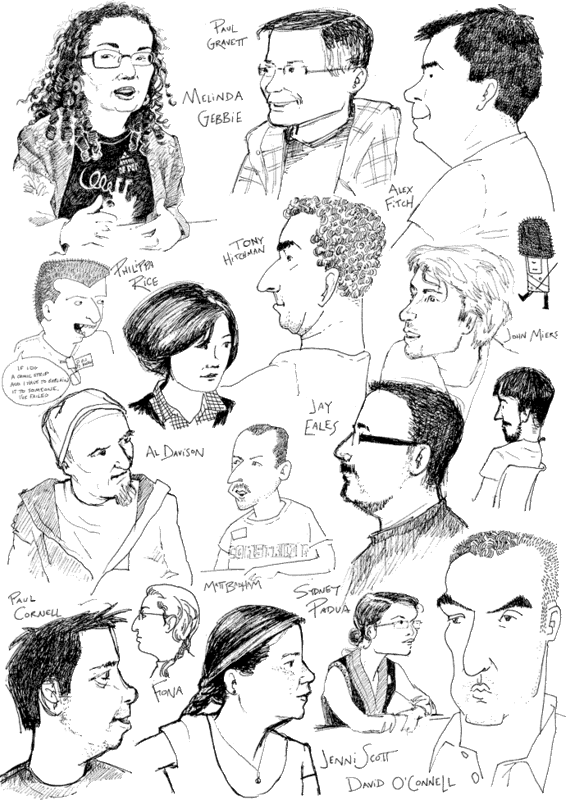
Thanks to organiser Selina Lock (![[info]](http://l-stat.livejournal.com/img/userinfo.gif) girlycomic) for this photo of me interviewing Darryl Cunningham about Psychiatric Tales, his new book with Blank Slate, soon to be published in the USA by Bloomsbury.
girlycomic) for this photo of me interviewing Darryl Cunningham about Psychiatric Tales, his new book with Blank Slate, soon to be published in the USA by Bloomsbury.
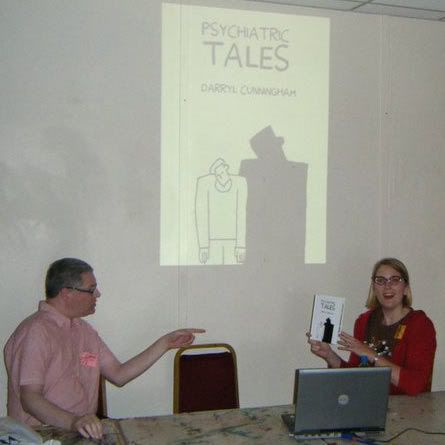
I find interviewing someone far more challenging than being interviewed (it involves more homework!) but I think it went well and Darryl sounded very pleased with it. Psychiatric Tales seems to be going down a storm with people who don't usually read comics, in various professions including medical, and I told him afterward that I see him as a real ambassador for us all, getting comics, and an appreciation of comics as a medium, out into the wider reading world.
One of the highlights of the weekend was getting to hang out with DFC buddy Neill Cameron, and I got to meet his wife, Di, and their son for the first time:
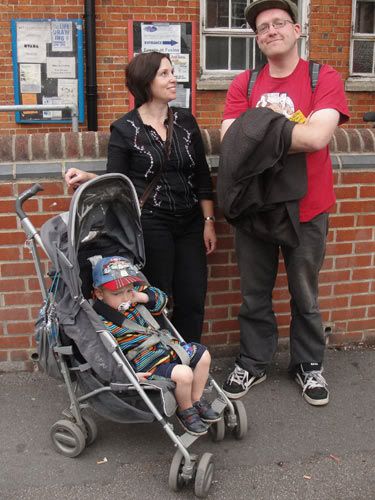
Unfortunately Kate Brown (Spider Moon) couldn't make at the last moment it since her partner Paul had to go to hospital (he's home now), but Neill and I realised this was the first of several times we may be doing talks together about our books and had a great time giving it a first run. We showed lots of pictures and talked about the DFC weekly magazine in its heyday, its recession-timed closure after issue 43, then about how the project couldn't die because of the way the DFC creators had become a living, supportive community. And for me, it couldn't die because Vern and Lettuce had become like members of my family, who were going to go on having adventures whether they were printed or not. Neill showed some amazing images from the makings of Mo-Bot High and talked about working with the editors to learn how to craft a high-quality storyline around his ideas and brilliant images.
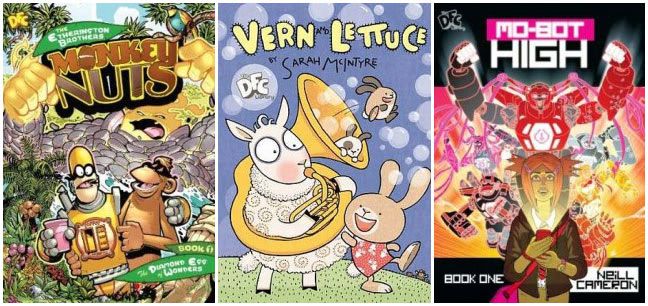
Here's the second round of DFC Library books in order of publication: 2 Sept, 30 Sept and 28 Oct. (Forbidden Planet International have put them on their Most Wanted List of comics in the next three months.) David Fickling's printing 5,000 of each book and they have to sell for the series to continue. Loads of pub
Last week I met up with comics creator Darryl Cunningham (![[info]](http://l-stat.livejournal.com/img/userinfo.gif) tallguywrites, author of Psychiatric Tales) to see Magnificent Maps at the British Library. (Note: I'm interviewing Darryl at Caption in August!)
tallguywrites, author of Psychiatric Tales) to see Magnificent Maps at the British Library. (Note: I'm interviewing Darryl at Caption in August!)

You can't beat the British LIbrary for good collections, and this exhibition had loads of amazing loot on display. I went to another exhibition of maps there, maybe five years ago, and I seem to remember it being a bit more bizarre, in a good way, but this exhibition was lush, with the most amazingly complex handmade maps you can imagine. Since making even the most detailed map is still a process of elimination (you'd have to recreate the 3-D world not to lose anything), it tells us so much about the priorities and prejudices of their makers. And the entrance hall looked lovely, it always makes me happy, the way they manage to resemble the whole place for a show:

I had a great time examining Grayson Perry's map of his own psyche, overlaid on a map of his body, crafted with a traditional printmaking technique. I also saw a fab coffee table book about his work in the giftshop, Grayson Perry by Jackie Klein and counted the days til my birthday. I really need to explore that guy's work more, I love the way he uses such traditional ways of working to say such up-to-date things. (Note to self, put him with Paula Rego and Alain Grée as people I want to find out more about.)
Darryl's another person who has a great appreciation for this printmaking aesthetic. As I looked at some of the maps with houses all pushed together, it reminded me very much of the way he draws buildings. Here's an example of Darryl's work, which will give you a taster for what you'll see at the British Library:
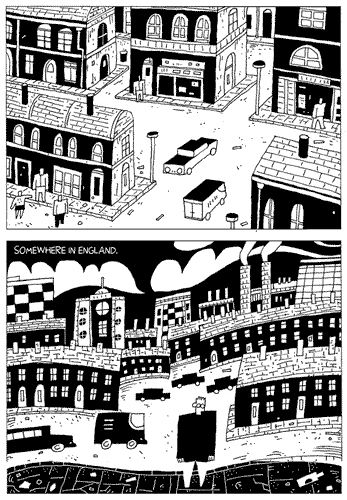
We weren't supposed to take photos in the exhibition, so here are just a couple snippets from a WW2 map:

(You might be able to guess this map's theme.)

Today's costume at the fab Discover centre in Stratford was more pink princess than space princess, but the princess prize goes to cartoonist Faz Choudhury for giving the best tip for getting big black scuff marks off white PVC boots. (Cif cleaning cream, it was. I tried every other chemical in the bathroom, kitchen and drinks cabinet but Cif worked best.)
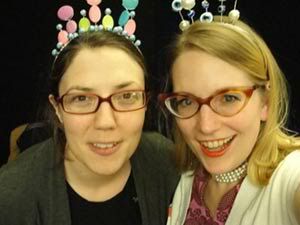
Here's Rebecca the excellent Stage Manager and the rest of the Discovery team that made things go so well today. I was worried the book might only appeal to girls because of the whole princess thing, but the boys were totally into ALIENS, and SPACE, all was good. I didn't realise that my hair was all over the place from our rather rambunctuous session. We did a lot of shouting and talking about bogeys and stuff. (I never thought this book would slide into Morris territory when I took on the script, but there you go.)
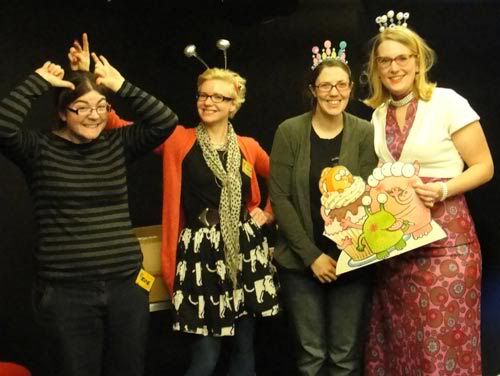
Yesterday my favourite animator, Marc Craste, had the session just after me, and today, just as I walked in the front door, the amazing David Roberts was coming out from his session! I should just hang out at the Discover centre all the time to catch glimpses of Britain's best talent.
Linky links! -----------
The Etherington Brothers have posted Lorenzo's great fan art for Dave Shelton's comic book Good Dog, Bad Dog. (Lettuce the rabbit still has a crush on those boys.)
You can listen online for about five more days to a BBC Scotland interview with manga artist Asia Alfasi and Darryl Cunningham (![[info]](http://l-stat.livejournal.com/img/userinfo.gif) tallguywrites), whose book Psychiatric Tales launches in a few weeks with Blank Slate and in the USA with Bloomsbury.
tallguywrites), whose book Psychiatric Tales launches in a few weeks with Blank Slate and in the USA with Bloomsbury.
My friend Alice Brewer pointed me to some fab photos by Malick Sidibé that I didn't see in this weekend's Guardian because the shop had run out. (Great stripey backgrounds and one woman has round glasses that look like something I'd draw.)
And Jamie Smart has written a remarkable tribute to his dad and created an amazing comic about their relationship. Totally unmissable.
Late night working, difficult morning. I'm not very good at winter mornings.

The marvellous writer of the book I illustrated, Morris the Mankiest Monster, Giles Andreae has lots of other tricks up his sleeve, including the famous Purple Ronnie series he originated, and his more recent line of stuff, Edward Monkton. Last week the Times ran a huge three-page section on his thoughts behind his new animation, The Pig of Happiness. While I could relate more to the Pig of Comfort this morning than the Pig of Happiness, I was hugely intrigued by his description of his breakdown into clinical depression. His stark, insightful description of it reminded me of the huge gulf between being depressed and suffering depression; people who have never suffered depression can't even start to appreciate the total wiping out of personality and horror that come with it. More than a call be 'be happy', I found it a call to be gentle and patient with people who are depressed, something I could use reminding about when I'm tempted to wish they'd 'snap out of it' or something equally callous. (Giles related that to someone telling a person with a broken neck to get a grip.)
You can read the whole article at Times Online here.
It also makes me think about how much creative people who have suffered serious mental health issues have to offer the rest of us in giving us a window into this whole world. Their contributions are so HUGELY valuable; it's enough just to write something worthy, that will only get a small audience. These guys know how to make the subject genuinely interesting, and what can be more interesting than the dark and strange places the mind can go. So few people are able really to communicate what breakdown and chronic suffering is like, or make us see things differently, want be more understanding and contemplate the fragile thread that keeps us all from falling into the same pit.
A lot of people in the comics community have come to value Leeds-based writer and artist Darryl Cunningham for having this very gift. He's someone who has struggled hugely with depression, but has retained a sensitivity to what others are going through and lets us see what really happens. Keep an eye out for his upcoming book, Psychiatric Tales, coming out with Blank Slate in February. You can see extracts from his book on Live Journal (he's ![[info]](http://l-stat.livejournal.com/img/userinfo.gif) tallguywrites), or to go straight to the autobiographical chapter, click on the image:
tallguywrites), or to go straight to the autobiographical chapter, click on the image:
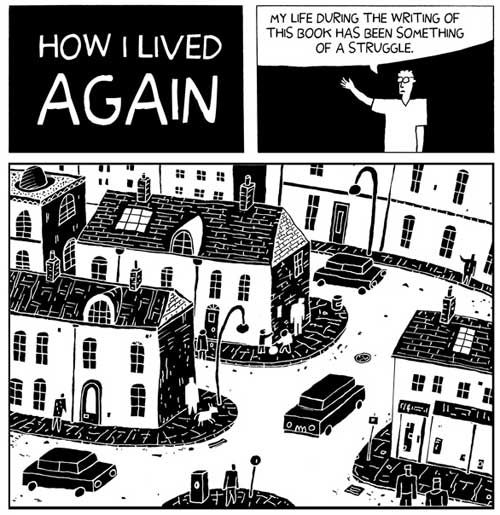
Thanks, Giles and Darryl! We all really need to hear this stuff, and you guys make us look forward to reading about it.
